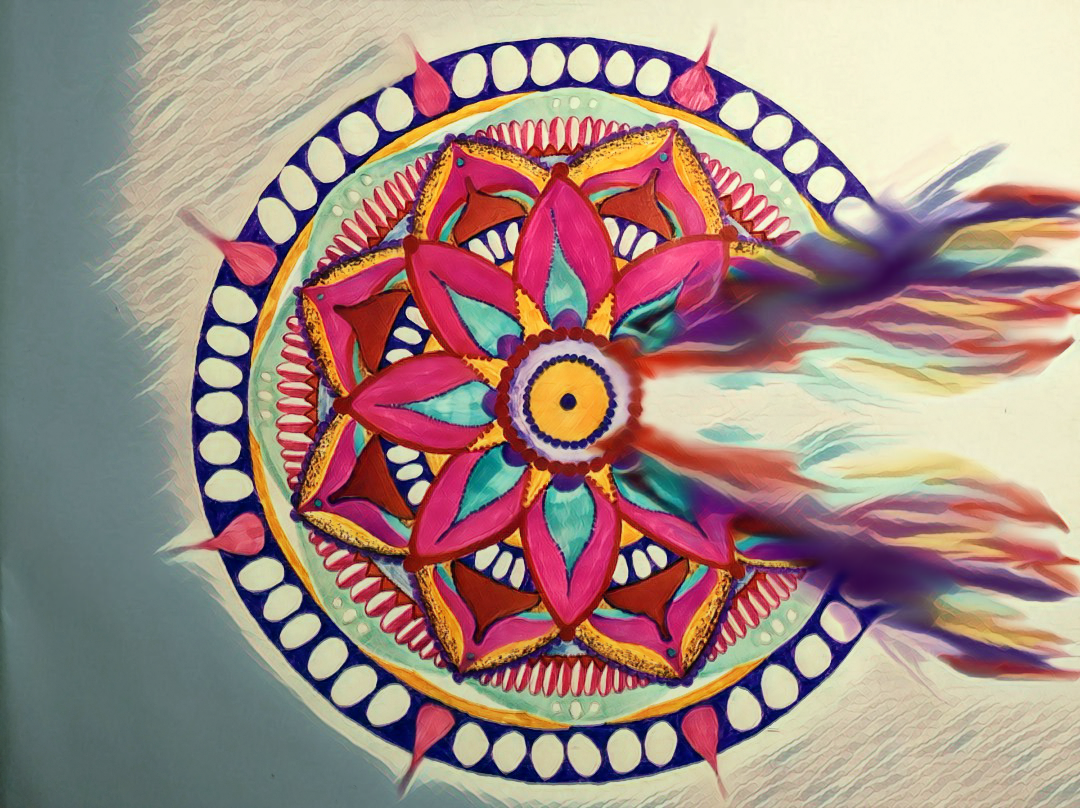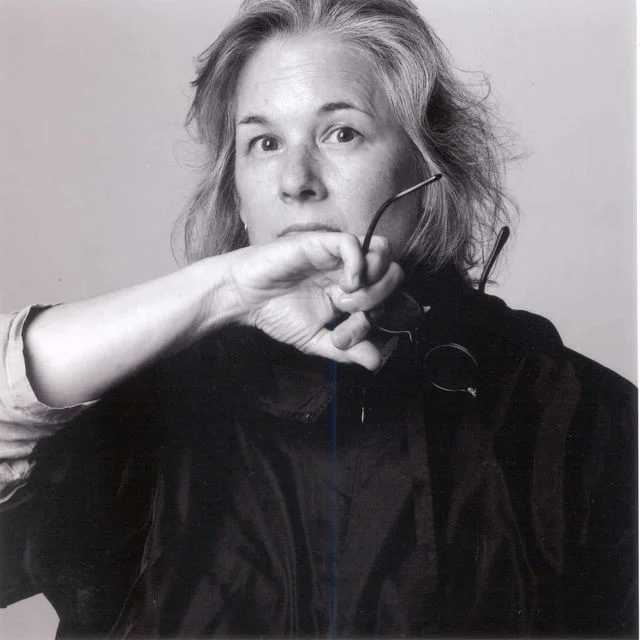DEB TEASLEY
Work based off the song “Turning Wake” by Ayla Nereo
Synesthetic artist Deb Teasley perceives colors when she listens to music. In this interview, she talks about her process of turning the colors she sees into elaborate mandalas, along with the ways in which her work is an essential therapy for dealing with her bipolar condition, and why mandalas emerged as the primary visual form she uses to express her synesthesia.
Interview by Tyler Nesler
Your type of synesthesia manifests as seeing colors when you hear music. It wasn't until your late twenties before you realized that most other people do not experience this phenomenon while listening to music. How did you finally make this discovery? Why do you think it took so long for you to realize the uniqueness of your condition?
I always knew that I connected to music differently, but I just thought it was a part of my creativity. And honestly, it just didn't seem profound enough to talk about, so I never really said anything to anyone. Which I realize now sounds ridiculous. I guess eventually I realized that other people didn't talk about songs having colors, so it really became this "oh, I'm just creative" kind of thing. It wasn't until I heard someone else who is synesthetic talk about their experience that I realized it was an actual thing and it had a name.
You were diagnosed with bipolar disorder around the same time that you discovered the distinctness of your synesthesia. Do you feel that exploring your synesthesia through art has been an essential therapeutic component for you?
Yes! Big time! My art has saved me from deeply suicidal depressions and floridly psychotic manic episodes. I've struggled for almost six years trying to find the right pharmaceutical medication to help me and my art was right there with me throughout the process. Despite being on the correct medication now, I still suffer mild symptoms of bipolar. I probably always will. My art helps soothe what the medications can't.
Were you making art before the bipolar diagnosis, and if so, how did the realization of your synesthesia and your bipolar condition change the direction or focus of your work?
Yes, I think art has always been a part of my life. I loved sketching as a kid and later moved into abstract art journaling. I even did some digital mash up work on HitRecord for awhile. Around the time I was diagnosed with bipolar, I had this urge to find a creative outlet that was unique, almost exclusive, to me. The sketches, the journaling, the digital work that I did previously...I kind of modeled it after other artists I liked. But there was something about the bipolar reality that I was living in that was screaming for me to find my own creative spirit. Mental illness can really have you operating in another dimension sometimes, you just lose touch with the world. It's scary when it's happening and it's scary for me to think back on it now. And I think in my confusion and fear art was this little light saying, "Hey girl, you're not totally lost. Here's a little piece of you right here. This is you."
The beginning color palette stage. The specific colors Deb perceives while listening to a piece of music are eventually transformed into a mandala.
How long did it take until mandalas emerged as the primary art form to express your synesthesia? What was the creative process of discovery that got you to this point?
It was around my late twenties that I became interested in mandalas and their meditative properties. I started collecting them on Pinterest and even printing them out to color in. Then slowly, I started to create my own. Once I figured out that I had synesthesia, which was a good five years later, I knew I wanted to create art using it, I just didn't know in what way. It took years of experimenting before I thought, "Hey, maybe I can use mandalas somehow…” Because up until that point I was merely trying to draw the music. And I was pretty terrible at it. With the mandalas it took the pressure off of capturing what I see and turned it in to a representation, an artistic expression.
What are the qualities of mandalas that make them work so well for you as expressions of seeing colors related to music? Do the ways in which the colors are presented in your mind match closely to the mandala form?
There's something about the patterns that really capture the texture of music for me. What I actually see is like water or sand and it moves to the rhythm. But there's also very clear lines where the colors come together and some of them are rather tedious while others are more simple. In my mind, it reminds me so much of a mandala. There's layers and layers of patterns. Some are ornate and some aren't. It also allows me to capture distinct parts of a song. I can look at a mandala and say, "This here is the violin, these are the vocals..." It's just a great way to tell a visual story.
Work based off the song “Echo’s Rose” by Elephant Revival
What kind of music do you like to listen to the most? Is there a particular type of music or even a particular musician or band which creates the most vibrant and colorful manifestation of your synesthesia?
I think in terms of purely seeking a beautiful synesthetic response, you can't go wrong with orchestra music. I am a real sucker for movie scores...Saving Private Ryan, Armageddon, anything by James Horner I am just in tears instantly because it's so beautiful. But in terms of what I listen to on a regular basis, I'm really into acoustic, singer-songwriter, coffee shop type stuff. I absolutely have a color palette...songs that are forest green, deep navy blue, and light purple. If a song comes on with those colors I know in the first couple of seconds that I'm going to love it.
You also create more abstract expressionist-based color pieces that are not as unified in form as your mandalas, or sometimes portions of your mandalas break off into these more abstract blended color forms. What do you think inspires you to create pieces like these which differ from your more classical circular mandala forms?
Those are actually a throw back to how I got started. I always wanted to be able to capture what I saw in music, but I didn't have the talent to do it with paint. Eventually I discovered that I could do it digitally. It's not perfect, but it's something, and it's close to how the colors interact in my mind. I think I post them because I want people to know that synesthesia doesn't produce mandalas, that's just my artistic take on it. The abstract pieces, that's how it all starts. It wasn't until recently that I started adding the abstract portions to the mandalas. It was a way for me to honor the true form of my synesthesia and the inspiration behind the work that I do. And it's funny, because most people see the mandala as melting away into something secondary. But in reality, the mandala is born from the abstract.
Work based off the song “Rhiannon” by Fleetwood Mac
Are your individual pieces often the result of listening to one song, or is there a variety of music/songs incorporated into each creation?
Nope, they are all one song! I drive my husband mad at times because I'll have a song on repeat for days on end. Once I have the patterns down and I know which colors are going where, then sometimes I'll switch it up. But I always do my best not to "contaminate" a piece with another song.
Are there any other types of sounds (natural or artificial) which also manifest as colors for you? Does a capella singing or even plain speaking voices also trigger images of color? Are there any other types of stimuli that ever create colors for you, or is sound the only one?
My one dog has a very particular bark. I call it her human bark because I always can tell there's a person near the house and not a rabbit or alley cat. It registers as a yellow/gold color for me. Sometimes when birds sing it also will have a color response, but not all the time. Besides that it's mainly music.
Have you considered making work in multimedia forms such as animation or live action video based on your synesthesia? Or three dimensional works, such as sculptures?
I would love to, but it would probably take me another lifetime to learn!
Work basked off the song “Toad Lick” by East Forest
What about making pieces in direct conjunction with a musician? For example, creating pieces directly for visual accompaniment to a full album or a live music performance?
This is my absolute dream! I would love to create a collection for an entire album of work. It would be interesting to see the similarities or patterns that emerge among the songs.
What's coming up in the near future for you? Are there any particular series, works, or shows that you would like people to know about?
I've been on an extended break this summer but will be re-opening my commissions again soon!
View more of Deb’s work on her site and on Instagram
You might also like our interviews with these artists:
Tyler Nesler is a New York City-based freelance writer and the Founder and Managing Editor of INTERLOCUTOR Magazine.











